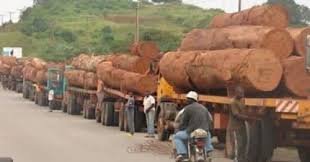By Amin Kef Sesay
Monitoring Social Media, The Calabash came across this post from a concerned citizen about the alarming rate at which Koinadugu district is been decimated off a particular specie of wood. The post reads:
“There is something very alarming about the rate at which “gbeni” trees are being transported out of Koinadugu because à certain Chinese tycoon wants them badly for expensive furniture in China.
“According to check point sources at Panlap (near Makeni) and Gbere Junction, some 40 trucks/trailers leave Koinadugu on a daily basis laden with “gbeni” logs for Freetown.
“Does anyone in Government care about this broad daylight plunder of the vegetation that makes Koinadugu’s weather à very pleasant one?
“Are the sons and daughters of Koinadugu not worried about the desertification of our district?
“Where is the Environment Protection Agency in all of this? Please save our forests in Koinadugu…
Few would argue that tropical forests are not important; as they offer a wide range of ecosystem services, including carbon sequestration, moderation of air and water quality, provisioning services and cultural services, as well as acting as biodiversity hotspots.
The dominant narrative is that once Sierra Leone was almost completely covered in forest and that the deforestation has been rapid and extreme – especially in the last ten years when the Government opened the floodgate to the export of raw, unprocessed timber to China and Europe.
Research shows that the greatest loss of forest is that of the Tonkolili Forest which has almost entirely disappeared.
All forests are under threat, with the northern Area forests under severe pressure from uncontrolled logging.
Luckily, in the south-east, the Gola Forest has legal protection backed up by serious inflow of funds from outside the country and more recently from payments from REDD+(Reducing Emissions from Deforestation and Forest Degradation).
The Loma Forest is to some extent protected by the poor road infrastructure and inhospitable terrain making commercial exploitation uneconomic.
With the country reported to have less than 5% forest cover left, the last national forest inventory was in 1975. A great deal of this could be done with remote sensing.
A new national forest inventory will first need to determine:
What decisions are expected to be made using the data (for example, allocation of land for industrial scale plantations, above ground biomass for compliance with REDD+, examining policies to improve resilience to rapid climate change, biodiversity condition assessment of protected areas, etc.)
Deforestation which is the permanent destruction of forests in order to utilize the land or trees should become a priority development issue for the central Government, local councils and paramount chiefs. Typically, deforestation is clearing a lot of trees without the intention of establishing future growth.
In Canada and America, all areas harvested must be reforested either by replanting or through natural regeneration.
Regenerating forests should become part of the country’s agricultural development plan; given that forestry (including planting of economic fruit trees, charcoal trees, etc.,) holds the potential to bring hundreds of millions of dollars into the economy; as well as provide thousands of new jobs.
Forests are vital to our Earth. Trees purify our air, filter our water, prevent erosion, and act as a buffer against climate change. They offer a home to plant and animal species while also providing natural resources such as medicine, food, timber, and fuel. Millions of rural dwellers live in forests.
In terms of Climate Change, forests are essentially the lungs of our planet. All plants take in carbon dioxide and release oxygen. Trees are able to convert more carbon dioxide than a regular plant.
Thus, when a forest is cut down, the humidity levels decrease and causes the remaining plants to dry out, as well as increased greenhouse gas emissions.
Removing trees thins the forest canopy which is meant to block sun rays during the day and holds in the heat at night. This damaging disruption leads to extreme temperature swings that are harmful to plants and animals. Many animals, insects, and plants lose their habitats and become endangered and even go extinct.
Hence the argument is that Government in the short, medium and long term has to put together a comprehensive national afforestation plan that should be fully funded in order to not only protect the remaining forest cover but to grow new ones in mitigating against climate change.






